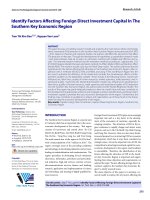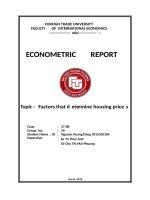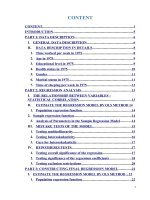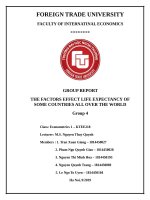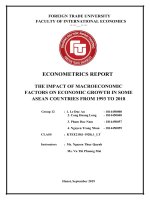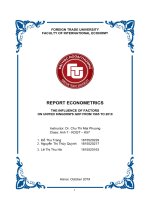tiểu luận kinh tế lượng ANALYSIS OF FACTORS AFFECTING FOREIGN DIRECT INVESTMENT (FDI) IN THE WORLD
Bạn đang xem bản rút gọn của tài liệu. Xem và tải ngay bản đầy đủ của tài liệu tại đây (664.95 KB, 17 trang )
FOREIGN TRADE UNIVERSITY
FACULTY OF BUSINESS ADMINISTRATION
----------
REPORT OF ECONOMETRICS
ANALYSIS OF FACTORS AFFECTING
FOREIGN DIRECT INVESTMENT (FDI) IN THE WORLD
Class ID: KTEE309(1-1920).2_LT
Student’s name
Nguyễn Thị Vân
Hoàng Phương Linh
Nguyễn Thị Như Quỳnh
Lê Ngọc Khánh Huyền
Nguyễn Quỳnh Giang
Student ID
1812250041
1817250021
1816250033
1812250019
1812250015
Lecturer: PhD. Dinh Thi Thanh Binh
Hanoi, 2019
TABLE OF CONTENTS
INTRODUCTION................................................................................................. 3
CONTENT............................................................................................................ 4
I.
Literature Review and Statistic Description.....................................................4
1. Literature Review............................................................................................ 4
2. Main content................................................................................................... 5
II. Statistic Description........................................................................................ 5
1. VARIABLE DESCRIPTION...........................................................................5
a. Running DES function...................................................................................5
b. Running SUM function................................................................................... 6
c. Running TAB1 function.................................................................................. 6
2. REGRESSION AND CORRELATION............................................................8
a. Set up model................................................................................................... 8
b. Analysing the correlation between independent variables................................9
c. Correlation relationship between variables......................................................9
d. Running function.......................................................................................... 10
3. TESTING MODEL....................................................................................... 11
a. Multicollinearity........................................................................................... 11
b. Heteroskedasticity......................................................................................... 13
c. Testing Multiple Linear Regressions: F Test..................................................14
d. Testing hypothesis in statistic.........................................................................15
IMPLICATION AND CONCLUSION..................................................................16
2
INTRODUCTION
In a growing society, econometrics has been a science with many practical applications,
especially issues related to human social life. Econometrics provides powerful tools that
enables economists to analyze the collected statistics and make predictions about social
phenomena. As students in the economic sector, we are well aware of the need to study and
research econometrics.
Foreign direct investment (FDI) is recognized as a powerful engine for economic growth. It
enables capital-poor countries to build up physical capital, create employment opportunities,
develop productive capacity, enhance skills of local labor through transfer of technology and
managerial know-how, and help integrate the domestic economy with the global economy.
Therefore, the identification of factors affecting the attraction of foreign investment and an
analysis of the impact of each factor to attract foreign investment is essential for the
government in offering policies to attract investment capital. And this aspect has inspired
our group to illustrate it detailedly with this report “Analysis of Factors Affects FDI in the
world”.
In “Analysis of Factors Affecting FDI in the world”, factors will be given in details and
collected data of following factors will be operated, calculated and explained. Further
description will be continuously attached to each section for further understandings. By the
end of this report is followed by a reasonable conclusion section to summarize our result as
a whole.
We would like to thank our instructor - PhD. Dinh Thi Thanh Binh for helping us with this
paper. In the process of making the report, although we have tried hard, but surely could not
avoid the errors, we hope that you will contribute to the completion of our report!
3
CONTENT
I.
Literature Review and Statistic Description
1.
-
Literature Review
Foreign direct investment (FDI): An investment made by a firm or individual in
one country into business interests located in another country in a year.
-
Population growth (pog): The rate of the increase in the number of individuals in a
population. Large populations provide a large market for products and services, have
a large labor force and a vast skill base. Considering the advantages of a large
population, it was hypothesized that investors would make larger investments in
countries with larger populations.
-
Inflation rate (ir) :Inflation is a quantitative measure of the rate at which the average
price level of a basket of selected goods and services in an economy increases over a
period of time. Rate of inflation is a crucial factor in influencing the inflow of foreign
investment. A high rate of inflation signifies economic instability associated with
inappropriate government policies.
-
Labor costs (lac) : The cost of labor is the sum of all wages paid to employees, as
well as the cost of employee benefits and payroll taxes paid by an employer. Wage as
an indicator of labour cost has been the most contentious of all the potential
determinants of FDI.
-
Public debt (pud) : The public debt is how much a country owes to lenders outside
of itself. These can include individuals, businesses, and even other governments. The
study employs a Vector Error Correction Model, which provides both the long run
and short run relationships among the variables. The long run results indicate that the
relationship between public debt and foreign direct investment, as well as interest
rate and FDI, is positive and statistically significant: the level of public debt should
increase so that the level of foreign direct investment can increase in the country.
2.
Main content
a)
4
Variables: There are 5 chosen variables:
b)
Outline: The report includes 4 main parts :
II.
Fdi: Dependent variable
Pog: Independent variable
Ir: Independent variable
Lac: Independent variable
Pud: Independent variable
Part 1 : Variables description using functions DES, TAB, SUM
Part 2 : Analyze regression model and correlation
Part 3 : Testing model
Part 4 : Conclusion
Statistic Description
1. VARIABLE DESCRIPTION
a. Running DES function
The most important information after using DES function is the variables label
des fdi pog ir lac pud
Table 1. Result from running DES function
By using des, we know clearly about the variables. According to the results, we know:
fdi: Foreign direct investment in a year (unit: USD)
pog: Population growth in a year (unit: percentage)
ir: Inflation rate in a year (unit: percentage)
lac: Labor costs in a year (unit: USD)
pud: Public debt in a year (unit: USD)
b. Running SUM function
SUM function lets us know about observations, mean, standard deviation, max and min
value of the variables.
sum fdi pog ir lac pud
5
Table 2. Result from using SUM function
By using SUM function, we have:
fdi: With 180 observations, the mean FDI per year is -1.84e+09, Std. Dev. is
2.59e+10. The minimum average FDI is -2.02e+11, the maximum average FDI is
1.332+11.
pog: With 216 observations, the mean population growth per year is 1.303029, Std.
Dev. is 1.307686. The minimum population growth is -3.91335, the maximum
population growth is 5.790631.
ir: With 203 observations, the mean inflation rate per year is 1.70359, Std. Dev. is
8.514521. The minimum inflation rate is -36.56478, the maximum inflation rate is
38.88166.
lac: With 192 observations, the mean Labor costs per year is 19352.66, Std. Dev. is
20301.35. The minimum Labor costs is 750, the maximum Labor costs is 121090.
pud: With 122 observations, the mean Public debt per year is 5.29e+10, Std. Dev. is
1.52e+11. The minimum Public debt is 1.17e+08, the maximum Public debt is
1.33e+12.
c. Running TAB1 function
Using TAB1 function allows to describe more than 1 variables coincidently with frequency
and percent of the variables.
tab1 fdi pog ir lac pud
6
7
Table 3. Result from running TAB1 with FDI in a year.
Example for analyzing information from the table:
FDI in a year ranges from -2.02e+11 to 1.33e+11.
2. REGRESSION AND CORRELATION
a. Set up model
Regression displaying the relationship between the dependent variable Y – Foreign Direct
Investment (FDI), and independent variables pog (X1 ), ir (X2 ), lac (X3 ), pud (X4 ) has the
following form:
General Regression Model
Sample Regression Model
= + pog + ir + lac+ pud
8
b. Analysing the correlation between independent variables
Using function:
corr fdi pog ir lac pud
The result is as below:
Table 4. Result from running CORR between independent variables
c. Correlation relationship between variables
FDI and pog is positive
The higher the population growth rate, the more FDI will be invested
FDI and ir is positive
The higher the Inflation rate is, the more FDI will be received
FDI and lac is negative
The higher the labour cost/worker wage is, the fewer FDI will be received
FDI and pud is negative
The higher the public debt is, the fewer FDI will be invested.
Types of correlation relationship:
0.1 > r: no correlation
0.1 < r < 0.3: weak correlation
0.3 < r < 0.5: medium correlation
0.5 < r: quite strong correlation
Overall, the independent variables do not have a quite strong correlation relationship with
the dependent one. Especially, the variable “ir” has a very weak relationship.
d. Running function
Using function:
reg fdi pog ir lac pud
9
The result is as below:
Table 5. Result from running regression
3. Variables
Coefficients
Pog
Ir
lac
pud
Values
-2.68e+09
3.47e+07
5.85e+07
250977.1
-0.0545
t
-1.7
0.68
0.91
2.27
-15.48
p-values
0.092
0.496
0.367
0.025
0.000
According to the above result, we now have: X1
General Regression Model:
Sample Regression Model:
+
Or
3. TESTING MODEL
a. Multicollinearity
Why is Multicollinearity a Problem?
If the goal is simply to predict Y from a set of X variables, then multicollinearity is not a
problem. The predictions will still be accurate, and the overall R-squared (or adjusted Rsquared) quantifies how well the model predicts the Y values. If the goal is to understand
how the various X variables impact Y, then multicollinearity is a big problem:
10
One problem is that the confidence intervals on the regression coefficients will
be very wide. The confidence intervals may even include zero, which means one
can’t even be confident whether an increase in the X value is associated with an
increase, or a decrease, in Y. Because the confidence intervals are so wide,
excluding a subject, can change the coefficients dramatically and may even
change their signs.
The second problem is that the individual P values can be misleading (a P value
can be high, even though the variable is important).
Beside, there are some several other problems can interfere with analysis of results,
including:
The t-statistic will generally be very small and coefficient confidence intervals
will be very wide. This means that it is harder to reject the null hypothesis.
The partial regression coefficient may be an imprecise estimate; standard errors
may be very large.
Partial regression coefficients may have sign and/or magnitude changes as they
pass from sample to sample.
Multicollinearity makes it difficult to gauge the effect of independent variables
on dependent variables.
Sources of Multicollinearity
There are four sources of multicollinearity:
The data collection method employed, for example, sampling over a limited
range of the values taken by the regression in the population.
Constraints on the model or in the population being sampled.
Model specifications, for example, adding polynomial terms to a regression
model, especially when the range of the X variable is small.
An over determined model. This happens when the model has more explanatory
variables than the number of observations. This could happen in medical
research where there may be a small number of patients about whom information
is collected on a large number of variables.
It is important to understand the differences among these sources of the multicollinearity, as
the recommendations for analysis of the data and interpretation of the resulting model
depend to some extent on the cause of the problem. The data collection method can lead to
11
multicollinearity problems when the analyst samples only a subspace of the region of the
regression. Constraints of the model can cause multicollinearity. An over defined model has
more regression variables than number of observations. These models are sometimes
encountered in medical and behavioral research, where there may be only a small number of
subjects (sample units) available, and information is collected for a large number of
regression on each subject. The usual approach to dealing with the multicollinearity in this
context is to eliminate some of the regression variables from consideration.
Effect of Multicollinearity
To assess multicollinearity, it should be noticed that how well each independent (X) variable
is predicted from the other X variables. And what is the value Variance Inflation Factor
(VIF). When VIF value is high for any of the X variables, the fit is affected by
multicollinearity.
We use VIF function to test multicollinearity of the model. If at least one of the coefficience
has VIF value is greater than 2, we can come to a conclusion that the model has
multicollinearity. The result is as follow:
Table 6: Results from running VIF
Mean VIF=1.29 < 2 → Does not have multicollinearity
b. Heteroskedasticity
Heteroskedasticity has serious consequences for the OLS estimator. Although the OLS
estimator remains unbiased, the estimated SE is wrong. Because of this, confidence
intervals and hypothesis tests cannot be relied on. In addition, the OLS estimator is no
longer BLUE. If the form of the heteroskedasticity is known, it can be corrected.
12
While studying classic linear regression model, we give out a hypothesis that the variance of
each Ui in the condition that the given value of explaining variable X is unchanged, which
means:
However, in fact, because of the nature of socio-economics, the method of gathering and
processing data or the wrong model, the hypothesis is violated causing heteroskedasticity.
The result of heteroskedasticity is that the minimum estimated square value is not efficient.
Therefore, the testing is no longer valuable.
Therefore, if p-value is smaller than 0.05, we reject H0 and accept H1
We use white function to test the model's error.
The result is as below:
Table 7. Results from running Imtest, white
Prob > chi2 = 0.0000 < 0.05, p-value = 0.0000 < 0.05
Hence, we reject H0 and accept H1, then there is heteroskedasticity.
13
c. Testing Multiple Linear Regressions: F Test
Using test function, the result is as below:
Table 8. Results from running Test
Hence, we accept H0 and reject the regression.
d. Testing hypothesis in statistic
Pog:
o Confidence Interval : (-6.59e+08; 1.35e+09)
o 0 Confidence Interval → Accept H0
o Population growth does not have statistically significant effect on Foreign
direct investment.
Lac:
o Confidence Interval : (31762.09; 470192.2)
o 0 Confidence Interval Reject H0, accept H1
o Labour cost in one year has statistically significant effect on FDI.
Pud:
o Confidence Interval : ( -0.0615 ; -0.0475)
o 0 Confidence Interval Reject H0, accept H1
o Public debt has statistically significant effect on Foreign direct investment.
Ir:
o Confidence Interval : ( -6.94e+07; 1.86e+08)
o Confidence Interval → Accept H
o Inflation doesn’t have statistically significant effect on Foreign direct investment.
0
15
IMPLICATION AND CONCLUSION
As a whole, after working on chosen database and analyzing, our group suggest the
best model to quantify the effects of some factors contributing to FDI.
In addition, to expand further, so how to increase in FDI of a country ? or What
should the government do to improve FDI ?
Firstly, based on a review of the latest research on the role of population in
economic growth and the determinants of FDI, it was hypothesized that a country's
population would be positively related to FDI. Large populations provide a large
market for products and services, have a large labor force and a vast skill base.
Considering the advantages of a large population, it was hypothesized that investors
would make larger investments in countries with larger populations. So, to increase in
FDI of a country, we also need to increase in population .
Secondly, when we decrease inflation rate, the FDI will increase because
inflation rate and foreign direct investment are adversely related. In other words with
an increase in the inflation rate the inflow of foreign investment decreases. The
negative relationship between inflation and foreign direct investment is due to the fact
that high level of prices in the country results in rising production costs. This is due to
the increase in input prices, cost of raw material, wages of labor, land prices and cost
of capital. Such high prices of product also adversely affects domestic as well as
foreign demand for commodities.
Thirdly ,to increase in FDI , we should decrease in public debts .when public
debts is low, it will ensure the economy will develop stably and benefit when
investing, then foreign investment will be effective, so FDI will increase.
Fourthly, the government should open markets and allow for FDI inflows.
Reduce restrictions on FDI. Provide open, transparent and dependable conditions for
all kinds of firms, whether foreign or domestic, including: ease of doing business,
access to imports, relatively flexible labour markets and protection of intellectual
property rights.
Fifthly ,the government should set up an Investment Promotion Agency (IPA).
A successful IPA could target suitable foreign investors and could then become the
16
link between them and the domestic economy. On the one side, it should act as a onestop shop for the requirements investors demand from the host country.
Finally, put up the infrastructure required for a quality investor: such as
sufficient close-by transport facilities (airport, ports), adequate and reliable supply of
energy, provision of an adequately skilled workforce, facilities for the vocational
training of specialised workers, ideally designed in cooperation with the investor
(Ibid.).
Our report was made based on the contributions of members with knowledge gained
from the process of studying and studying Econometrics. This is also a hands-on
opportunity for us to better understand the relevant analytical and characteristic tests,
apply the knowledge in the lecture hall to self-learn and draw useful conclusions about
phenomena in the various correlations and interplay between socio-economic
phenomena. Our team has completed the econometric model on the factors that affect
FDI data. Thus, through the results of the regression model, our team found that this
data set when being included in the model was not really appropriate, the explanation
of the independent variables was very low, and there were many errors in the process
perform .
Through this, my group also sincerely thanks for the guidance and enthusiastic
teaching of Ms. Dinh Thi Thanh Binh. Due to the limited knowledge and skills, this
report cannot avoid mistakes, we are looking forward to receiving your encouraging
suggestions so that we can improve and apply better in later jobs in the future.
17
